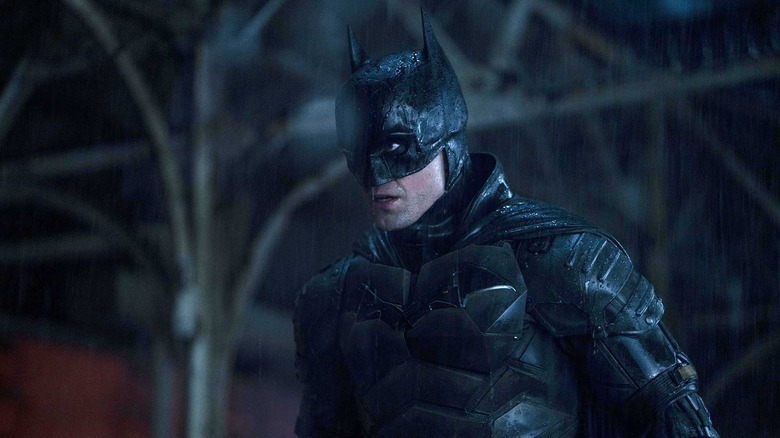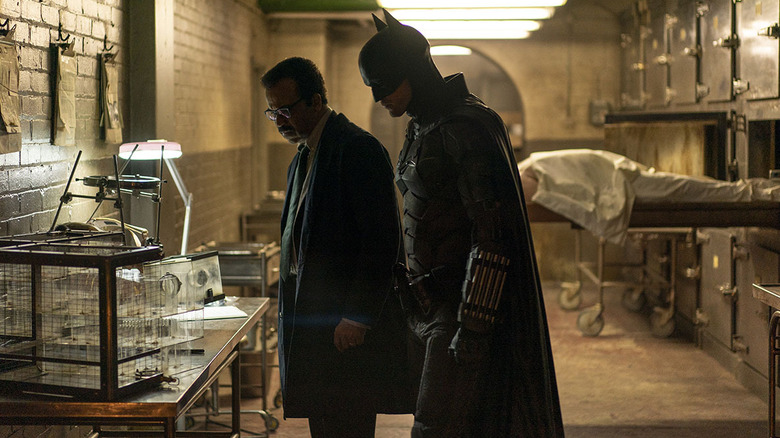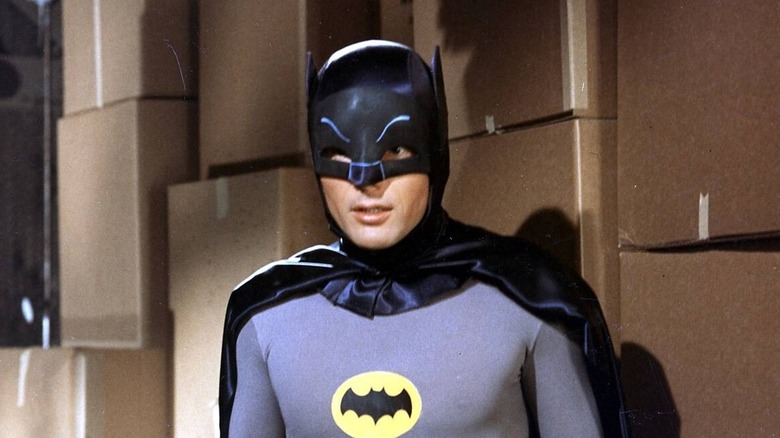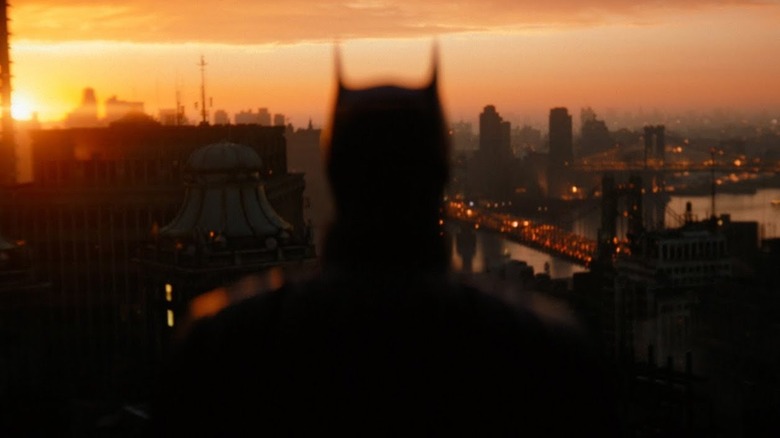The Batman Has A Suit Inspired By Vietnam, Adam West, And The Grim Reaper [Interview]
The Batsuit is Bruce Wayne's identity in "The Batman." He's in the second year of his gig as the Caped Crusader, but his days as the Bruce Wayne haven't even begun yet. He is The Batman and no one else. In director Matt Reeves' film, we spend more time than ever with the character behind the mask, and Glyn Dillon and David Crossman are the two artists responsible for creating that mask.
Together, the duo strived for realism with this new Batsuit, but they also landed on a deeply cinematic look — a costume that lives in the shadows. Expectations are always high for the recognizable costume, but without question, they surpassed the high bar here. Dillon and Crossman, who've previously worked on the "Star Wars" franchise, recently told us about creating the new suit and how Adam West inspired it.
'It's got this grim reaper feel to it'
How did Matt Reeves first describe his vision for "The Batman," and how did you want the suit to reflect that vision?
Dillon: From my memory, I definitely remember him saying how much he wanted to play towards it feeling very real, and I remember him saying how he wanted Batman to have freedom to move, and he wanted him to be able to fight like an MMA fighter. I think Dave and I both, from all our jobs previously, we know our taste is very similar. We both like things that feel very real. I think that's one of the reasons why [producer] Simon Emanuel got us this interview with Matt Reeves, because I think we all aligned very much in our taste as to how we could maybe do a newer version of Batman that felt very real.
You took inspiration from the Vietnam War, right?
Crossman: Yes, Vietnam is always in there somewhere. One of the things we took apart was the Vietnam-era flak jacket. Inside the bulletproof material are actually layers of Kevlar fabric, but layered on top of each other, so we thought, "Well, what we can do is form these or cut these into the shapes of the panels that you see on the torso of the Batsuit." The cowl really led the way initially. Often there's all these things, but it's always the head first, and then it leads on to what the suit would be.
Yet, in a way the cowl is slightly more fantastical than the suit, but I think they work well together because you want to retain an element of the Batman and the mystery, but the suit itself is this fully-flexible or functioning bulletproof number. We didn't want it to feel like a muscle suit, but it also gives Robert a good, dominating physicality without making him look pumped up, muscular, without giving him that feel. It just gives him a kind of brutish appearance.
Dillon: With the cowl, it is a more fantastical element of it, inasmuch as I like the idea of it feeling like the grim reaper, so that it's shaped more skull-like, and then maybe with the suggestion that he might have stretched the leather over a skull in order to get those shapes. Then the neck pieces are like vertebrae. So, it's got this grim reaper feel to it, which also then transferred over with [costume designer] Jacqueline [Durran]'s look of him when he's Bruce Wayne, with the eye makeup and the hood up walking through Gotham City.
I just think by the idea of stretching it over a skull, it differentiates itself from previous cinema iterations where the cowl looked much more like the face of a demon with a pointy nose and a furrowed brow. Which, obviously with the cowl, he's trying to intimidate and scare when people look him in the eyes, and I think knowing that he was going to be standing around talking to Gordon and doing all the detective work, I think it might have seemed a bit incongruous to have had a cowl with all of this extra drama built into it.
By doing something like a skull, which is kind of scary anyway but it has a neutral expression, I think it allows Robert to act. You can see great scenes like when he's talking to the Riddler near the end and what he's doing with his eyes, you're not distracted by the cowl. You're just looking at his eyes. I think that's what differentiates our cowl from the previous ones.
Crossman: You get a lot of Robert coming through, you get a lot of his jaw line. There's a lot of history on the cowl. There are a lot of bullet grazes and damage from previous encounters that Batman has had. All of that was built into the cowl from the beginning, so you could see that it's been around, we're in the second year of it and that kind of thing. He has history.
The movie truly lives up to the title, like the Bruce Wayne we know doesn't exist yet. Were you both aware that a large portion of Pattinson's performance was going to be in the suit?
Dillon: It's a long time ago since I read the script, but I don't think it really sunk in at the time just how much he is dressed as Batman throughout it. It was interesting to finally see it, and I'm glad we did what we did with the cowl, because I do think that it allowed Robert to express and emote, and you're just focusing on him, really, and there's not an angry cowl expression getting in the way.
Crossman: It's true. You're always looking at his eyes as reaction, and I think the same thing. I didn't realize until we saw the film just how much he's in it. I do feel you've got Robert through all of that, which I thought was a nice thing, really.
'I always wondered what that little square was on Adam West's nose'
What were some early ideas tested? What worked and what didn't?
Dillon: In terms of the drawings of the cowl, it's a bit of a blue sky process where we're just throwing in everything. I did one that actually kind of flared out of the back more like a helmet, but we quite quickly got rid of that, because it felt a bit too "Star Wars," if anything. Quite quickly the face, Matt was pleased with it, how it was. He liked the stitching around the top of the forehead, which was inspired by the Adam West, to be honest.
Having the little piece over the nose, again, that was kind of inspired by the Adam West. I always wondered what that little square was on Adam West's nose, and he obviously had the little arched eyebrows as well. When Matt had said about maybe he should feel like he's an MMA fighter, I liked the idea of it feeling a bit less elegant, a bit more like a bruiser, almost like if you had a Band-Aid stuck across his nose, and which was also the thought behind [Jack Nicholson's character] Jake in "Chinatown." The character Jake has a small bit of dressing on his nose. It was wanting to do something that was just a little bit more f***ed up than previous iterations of Batman, like having that feel a bit more brutal about it. But it was actually inspired by Adam West originally, that little square shape.
You both show a lot of reverence for the Adam West costume [designed by Jan Kemp].
Dillon: For me and Dave, it was the big TV show when we'd come home from school in the '70s. That was the favorite TV show.
Crossman: You were too young to realize that it was comedy or camp. You just thought, "This is great."
And you both managed to use a little yellow for the new suit.
Dillon: We did manage to sneak in some little bits of yellow, yeah. Just little bits of webbing on his arm. There's a little strapping on his arm that is yellow, and some little bits on the wing suit as well.
Capes are tricky, so how'd you two land on the cape he wears?
Crossman: Well, it's often tricky from a practical shooting point of view, because Batman's on a motorbike. You often can't have a full cape on a speeding bike and all that, so you have to work around those issues with visual effects. I think the thing is, you want the cape to reflect enough light and have enough personality. We wanted the cape to match the cowl, I remember that was very much a Matt request — the cape and the cowl should look the same. So, for the cape, because it has to behave in a different way, we used this lovely faux Japanese leather that we found, and it was a really good weight. It worked well in the wind, and it gave us lots of things that we needed to do.
You had many adaptations of the cape, and sometimes you shoot with no cape if visual effects were going to replace certain things for certain stunts. So, we had various lengths and various styles of cape to accommodate the shooting. But then once again, we didn't deviate from that fabric. That was the first fabric we looked at, and it went very well with the cowl, so we didn't change it.
Dillon: I really love that first fight scene he has with Catwoman. I think it looks really nice, the way that the mayor's house was lit and where they're spinning around fighting. I just thought the cape looked really nice in that scene.
'The marketing department wanted to add taller ears for it'
How about the bat logo on the chest? How'd that design come about?
Dillon: That was really fun. When I knew that we were doing it, that was one of the things I was secretly quite excited about. I purposely looked at lots of images of bats in flight to see what shapes they might make. I think I did a sheet of probably about 50 versions, some very stylized in the same way that some previous cinema versions were, and some that were very much taken from bats in flight. This one I think was a nice mixture of slightly stylized, but it was definitely taken from an image of a bat in flight. It did have tiny little ears, because that's literally where the real ears of the bat were. That's the one that we went with in the chest.
Honestly, I remember when it was all being talked about in terms of where it was going to be used elsewhere, I think the marketing department wanted to add taller ears for it, which is actually a shame, because I like the smaller ones. I thought they were different. But that was a really fun part of the job, and it's nice that the one that they use for the searchlight is our one with the tiny ears.
That's funny to hear, the marketing needed bigger ears on the costume. Why? Does it really make a difference?
Dillon: [Laughs] Yeah, it was interesting. I hadn't thought about it before, but when we were looking at it, we realized that one of the really old versions, I can't remember if it was the very first version, but one of the old comics versions didn't have any ears at all. It was just the wing shape. So I thought, "Well, yeah, we can do it with much lower-profile ears."
I do love how we turned it, and Matt wanted everything on the suit to have a use, for it all to be a utilitarian feeling with the suit. So, I think it was a great idea to have it as used as the weapon. Everything on the suit, including the cape, everything had its purpose. It made it very grounded.
Everyone has an expectation, an idea of what the costume should look like. Do you consider those expectations or just do what you and everyone actually involved in the film decides is best?
Crossman: Well, we've done "Star Wars" films before, so we're always constantly looking at characters from the past and seeing how you could adapt them whilst remaining true to the identity of that character. I think our intent is to try and improve slightly, and still kind of keep your fans happy, and then bring about changes that you're satisfied with which make more sense. With the Batsuit, it was always the movement and how you're so aware of the actor wearing the suit, the way they move their shoulders, their neck. I think one of the differences that we tried to do this time is you get more physicality from Robert. You can see more, and you don't feel the weight of this suit all the time. I think you see past it a bit more, and you see the actor within.
Dillon: I agree, and I think the great thing about getting the opportunity to work on a Batsuit is that is that all the years since it first came about in the comics, there have been so many different versions of it, both drawn in the comics and when it became a TV show and other films. I think it's an iconic character that can survive all these different iterations of itself, because it's such a strong initial design.
You're never going to be able to please all the fans all the time. There's some people who will just — Affleck is their Batman and it doesn't matter what you do, that's it. Which is fair enough, I respect that if that's their thing. So, we have to just be true to ourselves. Then me and Dave, we've both got the same taste, and luckily that aligned with what Matt Reeves was after, which is he wanted it to feel very real. That's exactly the kind of thing that we really like. Dave's a military expert, so Dave's influence is the reality of what soldiers have worn throughout history. I just love that feeling of things feeling real. So, it was great to be given the opportunity to work on such an iconic character and put our spin on it. It's great fun, and who could turn that down?
"The Batman" is now playing in theaters.



